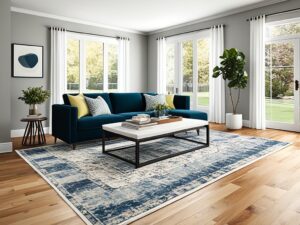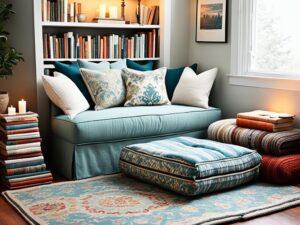When it comes to rugs, nothing is more frustrating than unruly corners that refuse to lay flat. Luckily, there are several simple and effective tips and tricks to keep your rug corners down. From choosing the right size rug to using double-sided tape or rug pads, these solutions will ensure that your rugs stay flat and secure on any type of floor surface.
Key Takeaways:
- Choose the right size rug for your space to prevent curling corners.
- Roll your rug up in the opposite direction to relax the fibers and flatten the corners.
- Let your rug sit in the sun to help the fibers relax and eliminate any bumps or lumps.
- Roll or fold the corners under and leave them that way for 24 hours to encourage flatness.
- Use double-sided tape, rug pads, or grippers to provide extra grip and keep the corners down.
Keeping rug corners down doesn’t have to be a difficult task. By following these easy tips and tricks, you can ensure that your rugs stay flat and secure. Whether you have hardwood floors or carpet, these techniques will help prevent rug corners from curling and create a safer, more aesthetically pleasing environment in your home.
Choose the Right Size Rug
One of the main reasons rug corners curl is because the rug is either too small or too large for the space. To prevent this issue, it’s important to choose the right size rug for your room. A rug that is too small will move around easily and the corners will shift. On the other hand, a rug that is too big may not lie flat and can overlap into unwanted areas. Measuring your space and selecting a rug that is proportional to the room will help ensure that the corners stay down and the rug fits perfectly.
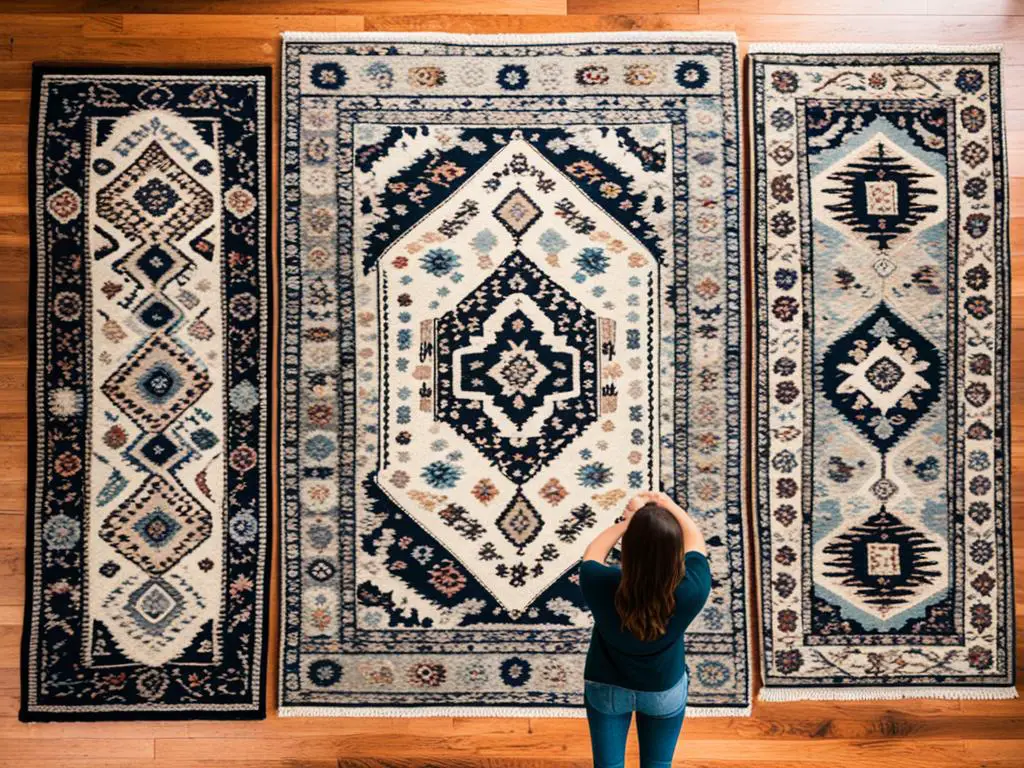
Factors to Consider when Choosing the Right Size Rug
1. Room Size: Determine the dimensions of the room to identify the appropriate rug size. Take into account the shape of the room and any furniture placement.
2. Rug Placement: Decide whether you want the rug to cover the entire floor or just a specific area. This will influence the size and shape of the rug you choose.
3. Furniture Borders: Consider whether you want the furniture to rest entirely on the rug or if you prefer a border of exposed flooring around the edges.
4. Room Function: Different rooms have different rug size requirements. For example, in a dining room, the rug should be large enough to accommodate the table and chairs, allowing ample space for movement.
Tips for Measuring and Selecting the Right Rug Size
- Measure the length and width of the room using a tape measure.
- Leave at least 18 inches of bare floor around the edges of the room for a cohesive, visually appealing look.
- Consider the scale of your furniture. The rug should be large enough to anchor the furniture and create a balanced visual composition.
- In open floor plans, use rugs to define separate areas and ensure that each area has its own appropriately sized rug.
- For irregularly shaped rooms, consider using multiple rugs to create distinct zones while maintaining harmony and coherence.
| Room | Rug Size | |
|---|---|---|
| Minimal | Standard | |
| Living Room | 5′ x 8′ | 8′ x 10′ or 9′ x 12′ |
| Dining Room | 4′ x 6′ | 8′ x 10′ or 9′ x 12′ |
| Bedroom (Twin Bed) | 4′ x 6′ | 5′ x 8′ |
| Bedroom (Full/Queen Bed) | 5′ x 8′ | 8′ x 10′ |
| Bedroom (King Bed) | 8′ x 10′ | 9′ x 12′ |
Roll the Rug Up the Opposite Way
If you unroll a rug and notice that the corners are curling, there’s a simple technique you can try to prevent this issue. Roll the rug up in the opposite direction. By doing so, you’ll be able to relax the carpet fibers, encouraging the corners to lay flat.
“Rolling the rug up in the reverse direction helps to redistribute the tension in the fibers, allowing them to settle and the corners to flatten out,” says rug expert Emily Thompson.
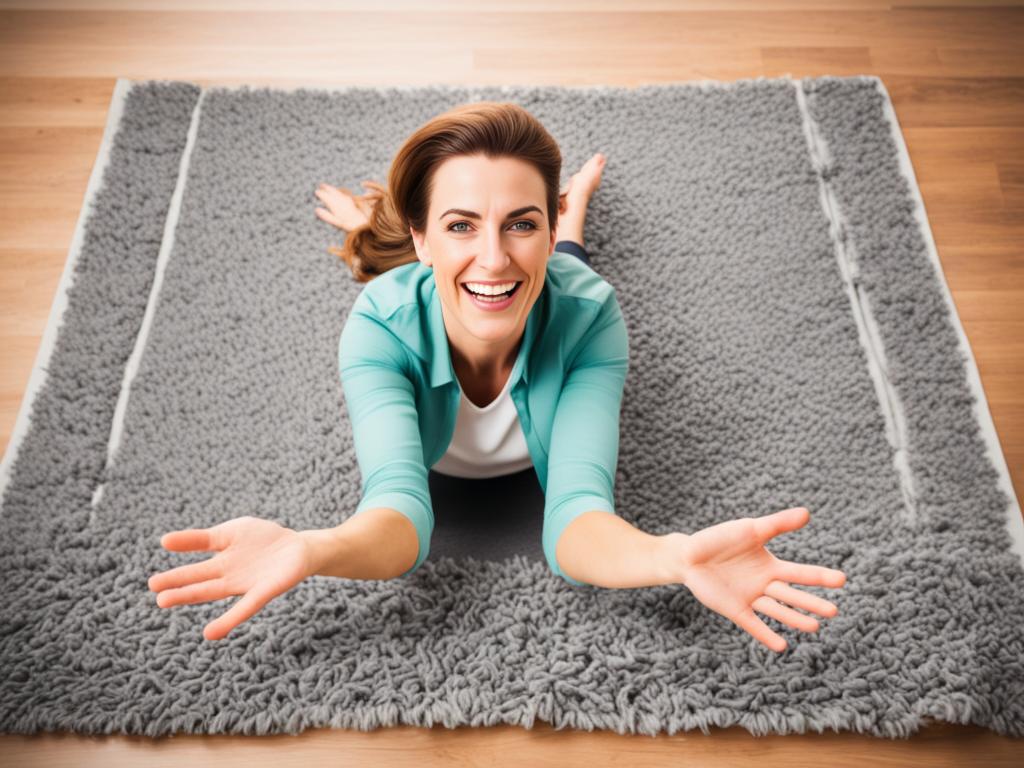
Leave the rug rolled up in the reverse direction for a few hours or even a few days. This will provide ample time for the fibers to adjust and the corners to flatten out naturally. Once you unroll the rug again, you’ll notice that the corners are less likely to curl and will stay down.
Remember, this technique is especially effective for new rugs or those that have been tightly rolled for a long time. Rolling the rug up in the opposite direction is a simple and practical solution to prevent rug corners from curling.
Sit Your Rug Out in the Sun
Sometimes, all you need is a little sunshine to solve your rug corner woes. On a warm day, lay your rug out in the sun and let nature work its magic. The heat from the sun helps to relax the rug fibers, smoothing out any lumps or bumps that may be causing curling corners. It’s a simple and effective solution that requires minimal effort.
However, it’s important to exercise caution when using this method. Synthetic fibers or rugs with rubber backing can be sensitive to extreme heat and may get damaged or even melt under direct sunlight. So, before leaving your rug out to bask in the sun, make sure it’s safe for your particular rug material.
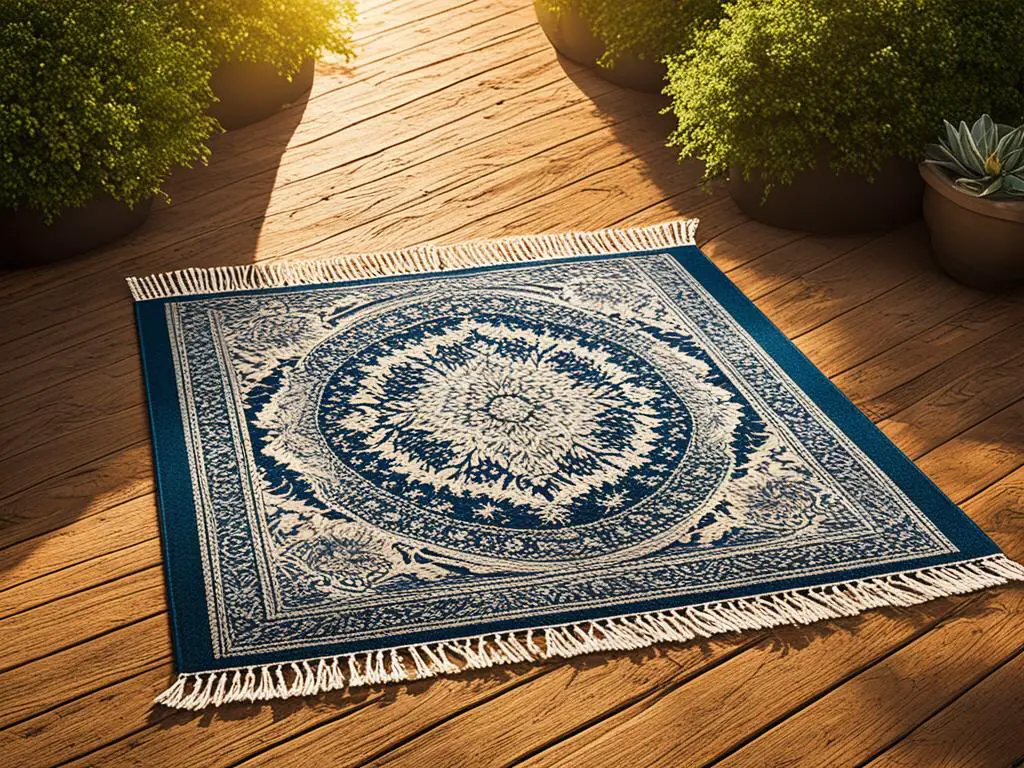
Remember, prevention is key to maintaining flat rug corners. By implementing the various tips and tricks we’ve discussed in this article, you can ensure that your rugs stay in place and look their best. From choosing the right size rug to using double-sided tape or rug pads, there are solutions for every type of rug and flooring surface.
| Advantages | Considerations |
|---|---|
| Relaxes rug fibers | May cause damage or melting for synthetic fibers or rugs with rubber backing |
| Easy and natural solution | Requires sunlight and warm weather conditions |
Roll or Fold the Corners
For stubborn rug corners that won’t stay down, try rolling or folding them under and let them sit that way for 24 hours. This method involves manually bending the curled corners until they are flat against the floor and tucking them in place. Be careful not to crease the rug in the opposite direction, as this could create new bumps or wrinkles.
| Pros | Cons |
|---|---|
|
|
Rolling or folding the corners of your rug is a simple technique that can help flatten out those stubborn curls. By manually bending the corners and keeping them tucked under, you encourage the rug to lay flat against the floor. This method is particularly effective for smaller rugs or rugs with lighter materials.
Pro Tip: If you’re having trouble getting the corners to stay in place, you can use a heavy object, such as a book or a decorative item, to weigh down the corners after rolling or folding them. This helps to apply pressure and encourage the corners to remain flat.
While rolling or folding the corners can provide a temporary fix, it may not work on extremely stubborn corners that refuse to stay down. In such cases, you may need to explore other solutions such as using rug pads or grippers.
Next Steps: Apply Double-Sided Tape or Use Rug Pads/Grippers
If rolling or folding the corners doesn’t solve the problem, don’t worry! There are still effective solutions to prevent rug corners from curling. In the next section, we’ll explore how double-sided tape and rug pads or grippers can keep your rug corners flat and secure.
Apply Double-sided Tape or Use Rug Pads/Grippers
When it comes to preventing rug corners from curling, there are a few effective solutions you can try. One quick fix is to use double-sided tape on the corners of your rug. This adhesive tape provides an extra grip, keeping the rug securely in place and preventing any curling. The tape adheres to both the rug and the floor, creating a strong bond that ensures the corners stay flat.
If tape isn’t your preferred method, you can also use rug pads or grippers underneath the rug. Rug pads are placed between the rug and the floor, providing additional traction and preventing the rug from slipping. This not only helps to keep the rug in position but also reduces the chances of the corners curling. Rug grippers, on the other hand, are specifically designed to target the corners. These grippers come in various shapes and sizes and can be attached to the corners of the rug, holding them firmly in place.
Using double-sided tape, rug pads, or grippers is an effective way to prevent rug corners from curling. Choose the method that suits your preferences and needs, and enjoy the benefits of a flat, secure rug.
Benefits of Using Double-sided Tape, Rug Pads, or Grippers:
- Prevents rug corners from curling
- Keeps the rug securely in place
- Reduces the chances of slipping or tripping
- Provides additional traction
- Easy to apply and remove
- Suitable for various types of rugs and floors
Whether you opt for double-sided tape, rug pads, or grippers, these solutions will help keep your rug corners down and maintain a neat and flat appearance. Choose the option that best suits your specific rug and floor type, and enjoy the peace of mind that comes with a securely anchored rug.
| Method | Usage | Pros | Cons |
|---|---|---|---|
| Double-sided Tape | Apply on rug corners | Strong adhesion, easy to use, suitable for various rugs | May leave residue on the floor when removed |
| Rug Pads | Place underneath the rug | Provides additional traction, prevents slipping | Requires proper sizing for a perfect fit |
| Rug Grippers | Attach to rug corners | Specifically designed for corner grip, reusable | May leave marks on the rug |
Conclusion
Keeping your rug corners down and preventing them from curling doesn’t have to be a difficult task. By following a few easy tips and tricks, you can ensure that your rugs stay flat, secure, and visually appealing in your home. From choosing the right size rug to using a variety of rug corner solutions, you can enjoy a safer and more comfortable environment.
One of the key factors in preventing rug corners from curling is selecting the right size rug for your space. Ensuring that your rug is proportionate to the room will help it stay in place and minimize any shifting or curling of the corners.
In addition to proper sizing, various rug corner solutions can be employed. Rolling or folding the corners in the opposite direction can help relax the fibers and encourage them to lie flat. Letting your rug sit in the sun on a warm day can also soften the fibers and fix any lumps or bumps. Applying double-sided tape to the corners or using rug pads or grippers underneath the rug can provide extra grip and prevent any movement or curling.
By implementing these techniques and considering the specific needs of your flooring, you can keep your rug corners down and enjoy a secure and stylish home. Say goodbye to frustrating curled rug corners and create a comfortable, aesthetically pleasing space for you and your family.

